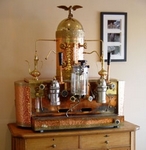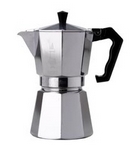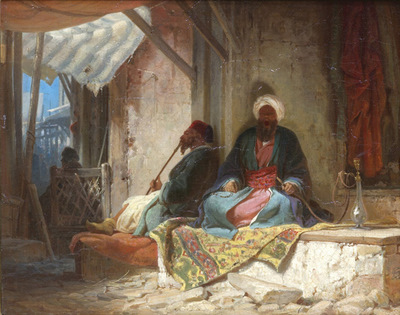Rumble: Living in Italy - Part 3: Coffee

It would be hard to think of Italy without coffee. "Caffè" (with the accent on the last part and with the 'è' pronounced as in the English "head") is part of the national heritage, much like the Colosseum or Pisa's tower.
Italy is home to a range of coffee drinks which took the rest of the world by storm. Without Italy, Starbucks or Second Cup probably would not exist.
Without coffee, Italy would grind to a halt. A day can not start without coffee, and a good meal often ends with it. Many companies have their own inhouse coffee bar including waiters and all. So just to make sure you understand: The Italians do take their "Caffè" seriously.
History:
 The coffee culture arrived from the Middle East via Istanbul to Venice, in the 1570's. Coffee would remain a luxury and mostly medicinal drink until the 17th century saw the opening of the first European coffeehouse in Venice. This new fashion statement quickly spawned over two hundred other similar establishments along the Venetian canals and into the major cities of Italy.
The coffee culture arrived from the Middle East via Istanbul to Venice, in the 1570's. Coffee would remain a luxury and mostly medicinal drink until the 17th century saw the opening of the first European coffeehouse in Venice. This new fashion statement quickly spawned over two hundred other similar establishments along the Venetian canals and into the major cities of Italy.Brewing coffee at home
 While in many parts of the world, we perculate coffee (pouring hot water onto the grind), in Italian homes the Mama's use a "Moka" (or caffettiera). Coffee is put into a grind holder (needs to be full, right "E"? - That is not "E" but the "other E", ha!) which fits onto the part holding the water. After the top is screwed onto it, the whole is put on a stove. As the water starts boiling, steam from the bottom is forced through the grind into the top part. Work of a genius, this is.
While in many parts of the world, we perculate coffee (pouring hot water onto the grind), in Italian homes the Mama's use a "Moka" (or caffettiera). Coffee is put into a grind holder (needs to be full, right "E"? - That is not "E" but the "other E", ha!) which fits onto the part holding the water. After the top is screwed onto it, the whole is put on a stove. As the water starts boiling, steam from the bottom is forced through the grind into the top part. Work of a genius, this is.Commercial espresso machines
 Once we found an original espresso machine in Venice: a large complicated copper and brass complex set of boiler and pipes which works in principle the same as the caffettiera.
Once we found an original espresso machine in Venice: a large complicated copper and brass complex set of boiler and pipes which works in principle the same as the caffettiera.The modern version of the espresso machine has gone through a number of changes. Lately, it has all kinds of sensors and computing power combined with the "steam engine" to ensure the water holds the right pressure and temperature. Technology in function of traditions aside, it does feel strange to see espresso machines with digital displays on it.
Italian coffee etiquette
In most places in the world, you would go and take a table in a coffee bar, and patiently wait... to be waited upon. This is not the habit in Italy. Most people here drink their coffee standing at the bar on their way to work. Tables are mostly used in the weekends, when you go and have your coffee with the family. In most busy coffee bars you need to pay for your coffee at the cashier before proceeding to the bar to show your receipt before ordering. This confuses tourists who queue up at the bar before paying. I have seen many an American turned back direction of the cashier after queueing up politely for five minutes.
Once the barman holds you in favour as you showed your receipt, to order an espresso in Italy, you simply ask for a "caffe". You drink it as it is hot, in two or three sips at most.
It is a habit, no, more a culture, strong: a religion, in Italy, not to drink any coffee with milk in it after breakfast. Cappuccino or Caffe Latte orders after 11 am are often laughed at or joked with.
While coffee bar tenders in the big cities will frown when you order a Caffe Latte in the afternoon, and exchange a glance of "Ah, tourists!" with the people standing at the bar, they will still serve you - all be it - reluctantly.
In restaurants, though, you might get occasions where the waiter will simply not serve you a coffee with milk in the afternoon or evening. The more remote the place, the more "mama and papa"-type the restaurant, the more chance of getting accused for "sacrilege", turning that 'friendly hospitable waiter' into a rude tiran who wants nothing better than to see your backside as you walk out of the restaurant, while all you wanted was a "Cappuccino".
In Italy even just the evil thought of "coffee with milk" is an eternal sin, equal to ask for Parmiggiano cheese to go on your Spaghetti Con Vongole, but more on that later.
Oh, and before I forget: "Coffee to go" is a "no go" in Italy. No such thing as serving coffee in a foam cup with a lid a la Starbucks...
If you ask for a "Caffe Via", the best you will get is a coffee in a plastic cup, which often melts in your hands as you walk out of the establishment.
Just to give you how foreign the idea of "coffee to go" is in Italy: Laura, my neighbour owns the coffee shop below my appartment. The kids once went to get a "Caffe Latte Via" for Tine, and Laura tried to accommodate them the best she could: She rinced a small plastic fruit juice bottle, poured the "Caffe Latte Via" into it, and put the lid on it.
Coffee, Coffee, Coffee. Which is your vice?
A handful of Italian coffee servings:
- Caffe: Is known as "espresso" in other countries. This is the "normal serving" of coffee in Italy. Caffe, served in a small cup, is strong in taste with a rich bronze froth known as a crema on top.
- Caffe Ristretto (or "Ristretto", "Stretto"): More concentrated than a regular espresso, as it is made with less water.
- Caffe Lungo (or "Lungo"): An Espresso with more water – opposite a Ristretto. Often referred to as Caffe Americano, not to be mistaken with perculated coffee, which is typically how Americans (and many others for that matter) normally take their coffee.
- Caffe Macchiato ("Macchiato" in short): Espresso "marked" with a dollop of steamed milk on top.
- Caffe Corretto ("Corretto"): Espresso with cognac, grappa, or sambuca liquor.
- Cappuccino (or "Cappuccio"): Espresso partially steamed and foamed milk.
- Cappuccino Chiaro: Cappuccino prepared with more milk (but less than a caffe latte) and is lighter in color.
- Caffe Latte: Espresso made with more milk than a cappuccino but only a small amount of foam. In Italy this is the usually a breakfast drink.
- Latte Macchiato: Steamed milk with a small "dot" of espresso coffee.
- Caffe Freddo: iced coffee
- Caffe Hag (or "Caffe Decaffinato"): decaffeinated coffee
- Caffe Marocchino: Espresso with a bit of hot milk and cacao powder.
- Granita di caffè (con panna): Frozen, iced similar to a slush, with ice shavings make it authentic, often "con panna" (with whipped cream)
- Caffe d'Orzo: barley coffee, a non-caffeine coffee substitute (not actually coffee)
- Caffe Shakerato: An iced and sweetened espresso drink, call it a "Coffee Shake".
- Scuro: (e.g. Cappuccino scuro or Caffe Latte scuro) Cappuccino prepared with less milk and is a darker color.
- Doppio: (e.g. Caffe Doppio, Caffe Latte Doppio) serving with a double shot of espresso.
- Senza Schiuma: (e.g: Caffe Latte Senza Schiuma) is served with no foam.
- Bollente: (e.g. Cappucino Bollente) extra heated refers to the milk in the coffee and not to the temperature of the coffee itself.
In the morning, I drink a "Caffe Latte Doppio Scuro", at noon it is time for a "Caffe Lungo Macchiato", and after-dinner, a simple "Caffe" goes down well.

More posts on "The Road" about Living in Italy
Pictures courtesy Johnlewis.com, auction.de. Text inspired by espressomakers.biz, Lifeinitaly.com.
 Peter. Flemish, European, aid worker, expeditioner, sailor, traveller, husband, father, friend, nutcase. Not necessarily in that order.
Peter. Flemish, European, aid worker, expeditioner, sailor, traveller, husband, father, friend, nutcase. Not necessarily in that order.
1 comments:
We had finished our coffee, which was loathsome as in all countries ...
where the accent of the word for coffee falls on the first syllable.
- Primo Levi
Truer words were never spoken.
Post a Comment